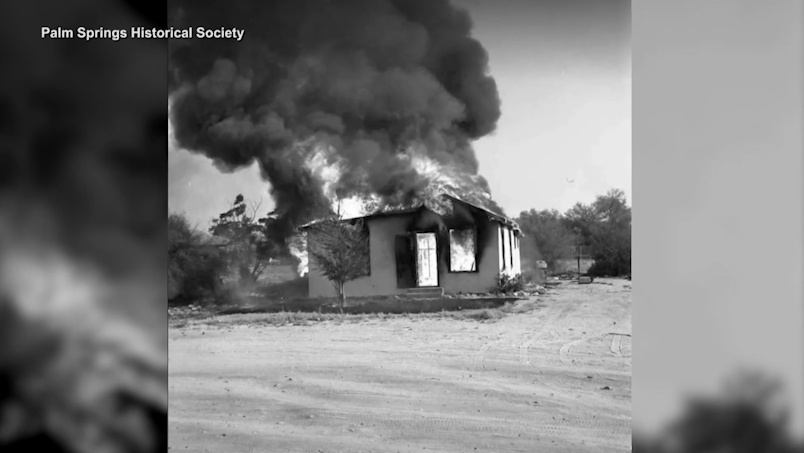I-Team digs into what really happened in the forced removal of Section 14 families in Palm Springs
The debate over racial reparations continues to intensify in Palm Springs. It's centered on one square mile of land known as Section 14 next to downtown Palm Springs which was cleared for new development over 50 years ago.
The attorney representing Section 14 families and their descendants pointed out that Palm Springs apologized for its role in the clearing of the land and the bulldozing and burning of homes.

In announcing a claim against the city in November of 2022, she argued that an Attorney General's report backs up her allegations.
Former Palm Springs City Manager Norm King disagrees saying, "I don't think there's any factual basis of that in his report or anything else that has been reported of that era, period."
Two distinct sides of the story.
King argues it's much more complicated, "I think the city has been made a fall guy you might say for a very complex, inevitable situation in which finally the Indian landowners got their rights to their land and wanted to exercise the value of that land."
The statue of King's friend, former Mayor Frank Bogert was removed from city hall in July of 2022 after the city council apologized in 2021 for the city's role in the clearing of section 14.
We have combed through the records of Palm Springs' past, looking at many of the documents.
Some of them can be found on the city's website.
Others can be found in the archives at the Palm Springs Historical Society.
There may be more than two sides to this story. There are the residents of Section 14 and their descendants. There's the City of Palm Springs. There's also the Bureau of Indian Affairs. And the Agua Caliente Indians and the tribe's members.
Former Tribal Chairwoman Vyola Ortner wrote about the tribe's story, convincing Congress to grant them long-term leasing, in her book "You Can't Eat Dirt."
Long-term leasing greatly enhanced the value of the Tribe's land and started to bring interest from developers, eventually leading to the Spa Hotel which began to provide the Tribe with new opportunities for growth.
In a 2013 interview about the book on C-Span, Ortner said, "You didn't always agree with the city, or do what the city wanted us to do but we had this relationship where we could talk about it or discuss it."
This letter shows the city and the tribe did work together on the clearing of Section 14:
The letter is from Agua Caliente Tribal Chair Edmund Siva to the Palm Springs City Council in April of 1966 thanking the council for help on its "clean-up campaign."
Recently discovered documents show the city has letters from the Bureau of Indian Affairs communicating its appreciation and guidance on the efforts to remove structures and debris from the properties in Section 14.
There are also burn permits signed by tribal allottees or conservators.
Former Palm Springs Planning Director Marvin Roos says, "The bureau represented to the city that the notice was given."
Our calls and e-mails to the tribe requesting comment for this story have not been returned.
We did obtain this letter from Former Tribal Chairman Jeff Grubbe to the Chair of the Human Rights Commission in 2021 in reference to the removal of the statue of Frank Bogert.
Grubbe took exception with non-Indians on both sides of the argument.
He also writes, "To be very clear, this matter is of no concern to the Tribe."
He does promise that the tribe will tell its story about Section 14 in an exhibit at the new cultural museum in downtown Palm Springs. That museum is scheduled to open sometime soon.
King doesn't believe the Tribe did anything wrong and says, "It's their choice whether to talk about it or not."
The attorney for the Section 14 families also declined to be interviewed for this story.
Same with all five city council members because of the threat of litigation, though they have spoken out in the past.
Councilmember Christy Holstege appeared at the news conference announcing the claim against the city in November 2022
She said, "Those actions were wrong then. They are wrong now. They created devastation and trauma in our communities."
Councilmembers also spoke at their meeting on April 27 when they voted 3 to 2 to hold off on hiring a consultant for a reparations program.
Council Member Lisa Middleton said, "We need to remind everyone that nothing happened here until there was an act of congress that gave back to the Agua Caliente people control of their land."
A statement from City Attorney, Jeff Ballinger reads in part, "While the council decided not to proceed with the consultant contract that was presented to council, the council unanimously reiterated its desire to continue its pursuit of a reparations program.”
News Channel 3 has been reporting on Section 14 for several years. Check Out some of our previous reports on the issue:
- April 2023: Palm Springs City Council rejects consultant agreement to develop Section 14 reparations program services
- April 2023: Palms Springs Section 14 Survivors and descendants are developing demands for reparations
- March 2023: Palm Springs releases hundreds of pages of archived documents on Section 14 and Frank Bogert
- September 2021: Palm Springs to apologize for Section 14 destruction; moves forward with process to remove Frank Bogert statue

